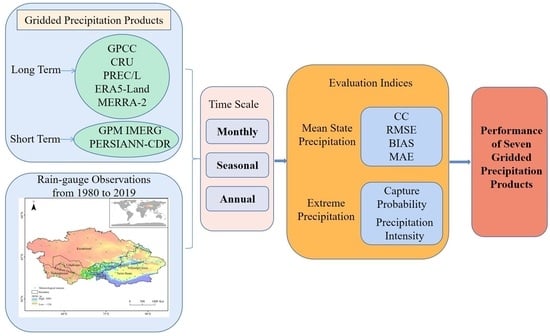Performance of Seven Gridded Precipitation Products over Arid Central Asia and Subregions
Abstract
1. Introduction
2. Materials and Methods
2.1. Study Area
2.2. Observations
2.3. Gridded Precipitation Products
2.4. Methods
2.4.1. Evaluation Indices for Mean State Precipitation
2.4.2. Evaluation Indices for Extreme Precipitation
3. Results
3.1. Accuracy in Describing the Temporal Change in Precipitation
3.1.1. Annual and Seasonal Variations in Precipitation
3.1.2. Comprehensive Performance by Evaluation Indices
3.2. Accuracy in Describing the Spatial Distribution of Precipitation
3.2.1. Spatial Distribution and Trend of Annual Precipitation
3.2.2. Comprehensive Performance by Evaluation Indices
3.3. Accuracy in Describing Extreme Precipitation Events
3.3.1. Capture Probability
3.3.2. Precipitation Intensity
4. Discussion
5. Conclusions
Author Contributions
Funding
Data Availability Statement
Acknowledgments
Conflicts of Interest
References
- Pörtner, H.-O.; Roberts, D.C.; Tignor, M.; Poloczanska, E.S.; Mintenbeck, K.; Alegría, A.; Craig, M.; Langsdorf, S.; Löschke, S.; Möller, V.; et al. IPCC, 2022: Climate Change 2022: Impacts, Adaptation, and Vulnerability. Contribution of Working Group II to the Sixth Assessment Report of the Intergovernmental Panel on Climate Change; Cambridge University Press: Cambridge, UK; New York, NY, USA, 2022; p. 3056. [Google Scholar] [CrossRef]
- Yang, S.; Xu, W.H.; Xu, Y.; Li, Q.X. Development of a Global Historic Monthly Mean Precipitation Dataset. J. Meteorol. Res. 2016, 30, 457. [Google Scholar] [CrossRef]
- Tian, W.; Liu, X.; Wang, K.; Bai, P.; Liang, K.; Liu, C. Evaluation of Six Precipitation Products in the Mekong River Basin. Atmos. Res. 2021, 255, 105539. [Google Scholar] [CrossRef]
- Peng, J.; Liu, T.; Huang, Y.; Ling, Y.; Li, Z.; Bao, A.; Chen, X.; Kurban, A.; De Maeyer, P. Satellite-Based Precipitation Datasets Evaluation Using Gauge Observation and Hydrological Modeling in a Typical Arid Land Watershed of Central Asia. Remote Sens. 2021, 13, 221. [Google Scholar] [CrossRef]
- Shen, Y.; Feng, M.; Zhang, H.; Gao, F. Interpolation Methods of China Daily Precipitation Data. J. Appl. Meteorol. Sci. 2010, 21, 279–286. [Google Scholar] [CrossRef]
- Fang, X.; Guo, X.L.; Zhang, C.; Shao, H.; Zhu, S.H.; Li, Z.Q.; Feng, X.W.; He, B. Contributions of Climate Change to the Terrestrial Carbon Stock of the Arid Region of China: A Multi-Dataset Analysis. Sci. Total Environ. 2019, 668, 631–644. [Google Scholar] [CrossRef]
- Ahmed, K.; Shahid, S.; Chung, E.S.; Wang, X.J.; Bin Harun, S. Climate Change Uncertainties in Seasonal Drought Severity-Area-Frequency Curves: Case of Arid Region of Pakistan. J. Hydrol. 2019, 570, 473–485. [Google Scholar] [CrossRef]
- Harris, I.; Osborn, T.J.; Jones, P.; Lister, D. Version 4 of the CRU TS Monthly High-Resolution Gridded Multivariate Climate Dataset. Sci. Data 2020, 7, 1–18. [Google Scholar] [CrossRef]
- Schneider, U.; Becker, A.; Finger, P.; Rustemeier, E.; Ziese, M. GPCC Full Data Monthly Product Version 2020 at 0.25°: Monthly Land-Surface Precipitation FromRain-Gauges Built on GTS-Based and Historical Data; Global Precipitation Climatology Centre (GPCC) at Deutscher Wetterdienst: Offenbach, Germany, 2020. [Google Scholar] [CrossRef]
- Yatagai, A.; Kamiguchi, K.; Arakawa, O.; Hamada, A.; Yasutomi, N.; Kitoh, A. APHRODITE: Constracting a Long-Term Daukt Gridded Precipitation Dataset for Asia Based on a Dense Network of Rain Gauges. BAMS 2012, 93, 1401–1415. [Google Scholar] [CrossRef]
- Jiang, G.; Sun, X. Application of Grid Precipitation Datasets in Summer Precipitation Variability over East China. J. Meteorol. Sci. 2016, 36, 448–456. [Google Scholar] [CrossRef]
- Adler, R.F.; Sapiano, M.R.P.; Huffman, G.J.; Wang, J.J.; Gu, G.; Bolvin, D.; Chiu, L.; Schneider, U.; Becker, A.; Nelkin, E.; et al. The Global Precipitation Climatology Project (GPCP) Monthly Analysis (New Version 2.3) and a Review of 2017 Global Precipitation. Atmosphere (Basel) 2018, 9, 138. [Google Scholar] [CrossRef] [PubMed]
- Huffman, G.J.; Stocker, E.F.; Bolvin, D.T.; Nelkin, E.J. GPM IMERG Final Precipitation L3 1 Month 0.1 Degree x 0.1 Degree V06; Goddard Earth Sciences Data and Information Services Center (GES DISC): Greenbelt, MD, USA, 2019. [CrossRef]
- Nguyen, P.; Shearer, E.J.; Tran, H.; Ombadi, M.; Hayatbini, N.; Palacios, T.; Huynh, P.; Updegraff, G.; Hsu, K.; Kuligowski, B.; et al. The CHRS Data Portal, an Easily Accessible Public Repository for PERSIANN Global Satellite Precipitation Data. Nat. Sci. Data 2019, 6, 180296. [Google Scholar] [CrossRef] [PubMed]
- Kim, J.; Han, H. Evaluation of the CMORPH High-Resolution Precipitation Product for Hydrological Applications over South Korea. Atmos. Res. 2021, 258, 105650. [Google Scholar] [CrossRef]
- Muñoz Sabater, J. ERA5-Land-Land Monthly Averaged Data from 1950 to 1980; Copernicus Climate Change Service (C3S) Climate Data Store (CDS): Luxembourg, 2021. [Google Scholar] [CrossRef]
- Randles, C.A.; da Silva, A.M.; Buchard, V.; Colarco, P.R.; Darmenov, A.; Govindaraju, R.; Smirnov, A.; Holben, B.; Ferrare, R.; Hair, J.; et al. The MERRA-2 Aerosol Reanalysis, 1980 Onward. Part I: System Description and Data Assimilation Evaluation. J. Clim. 2017, 30, 6823–6850. [Google Scholar] [CrossRef]
- Chen, M.; Xie, P.; Janowiak, J.E. Global Land Precipitation: A 50-Yr Monthly Analysis Based on Gauge Observations. J. Hydrometeorol. 2002, 3, 249–266. [Google Scholar] [CrossRef]
- Cheng, X.; Wang, Y.; Li, G.; Li, Q. Evaluation of Three Reanalysis Precipitation Datasets in China. Progress. Inquisitiones Mutat. Clim. 2013, 9, 258–265. [Google Scholar] [CrossRef]
- Shi, H.; Li, T.; Wei, J. Evaluation of the Gridded CRU TS Precipitation Dataset with the Point Raingauge Records over the Three-River Headwaters Region. J. Hydrol. 2017, 548, 322–332. [Google Scholar] [CrossRef]
- Basheer, M.; Elagib, N.A. Performance of Satellite-Based and GPCC 7.0 Rainfall Products in an Extremely Data-Scarce Country in the Nile Basin. Atmos. Res. 2019, 215, 128–140. [Google Scholar] [CrossRef]
- Faiz, M.A.; Liu, D.; Fu, Q.; Sun, Q.H.; Li, M.; Baig, F.; Li, T.X.; Cui, S. How Accurate Are the Performances of Gridded Precipitation Data Products over Northeast China? Atmos. Res. 2018, 211, 12–20. [Google Scholar] [CrossRef]
- Moazami, S.; Najafi, M.R. A Comprehensive Evaluation of GPM-IMERG V06 and MRMS with Hourly Ground-Based Precipitation Observations across Canada. J. Hydrol. 2021, 594, 125929. [Google Scholar] [CrossRef]
- Mahmoud, M.T.; Mohammed, S.A.; Hamouda, M.A.; Mohamed, M.M. Impact of Topography and Rainfall Intensity on the Accuracy of IMERG Precipitation Estimates in an Arid Region. Remote Sens. 2020, 13, 13. [Google Scholar] [CrossRef]
- Hinge, G.; Hamouda, M.A.; Long, D.; Mohamed, M.M. Hydrologic utility of satellite precipitation products in flood prediction: A meta-data analysis and lessons learnt. J. Hydrol. 2022, 612, 128103. [Google Scholar] [CrossRef]
- Chen, F.H.; Huang, W.; Jin, L.Y.; Chen, J.H.; Wang, J.S. Spatiotemporal Precipitation Variations in the Arid Central Asia in the Context of Global Warming. Sci. China-Earth Sci. 2011, 54, 1812–1821. [Google Scholar] [CrossRef]
- Yao, J.; Chen, Y.; Chen, J.; Zhao, Y.; Tuoliewubieke, D.; Li, J.; Yang, L.; Mao, W. Intensification of Extreme Precipitation in Arid Central Asia. J. Hydrol. 2021, 598, 125760. [Google Scholar] [CrossRef]
- Schiemann, R.; Luthi, D.; Vidale, P.L.; Schar, C. The Precipitation Climate of Central Asia—Intercomparison of Observational and Numerical Data Sources in a Remote Semiarid Region. Int. J. Climatol. 2008, 28, 295–314. [Google Scholar] [CrossRef]
- Dilinuer, T.; Yao, J.; Chen, J.; Zhao, Y.; Mao, W.; Li, J.; Yang, L. Systematical Evaluation of Three Gridded Daily Precipitation Products Against Rain Gauge Observations Over Central Asia. Front. Earth Sci. 2021, 9, 1–17. [Google Scholar] [CrossRef]
- Hu, Z.; Ni, Y.; Shao, H.; Yin, G.; Yan, Y.; Jia, C. Applicability Study of CFSR, ERA-Interim and MERRA Precipitation Estimates in Central Asia. Arid Land Geogr. 2013, 36, 700–708. [Google Scholar] [CrossRef]
- Lai, S.; Xie, Z.; Bueh, C.; Gong, Y. Fidelity of the APHRODITE Dataset in Representing Extreme Precipitation over Central Asia. Adv. Atmos. Sci. 2020, 37, 1405–1416. [Google Scholar] [CrossRef]
- Guo, H.; Chen, S.; Bao, A.; Hu, J.; Gebregiorgis, A.; Xue, X.; Zhang, X. Inter-Comparison of High-Resolution Satellite Precipitation Products over Central Asia. Remote Sens. 2015, 7, 7181–7211. [Google Scholar] [CrossRef]
- Hu, Z.; Hu, Q.; Zhang, C.; Chen, X.; Li, Q. Evaluation of reanalysis, spatially interpolated and satellite remotely sensed precipitation data sets in central Asia. J. Geophys. Res. Atmos. 2016, 121, 5648–5663. [Google Scholar] [CrossRef]
- Peña-Guerrero, M.D.; Umirbekov, A.; Tarasova, L.; Müller, D. Comparing the performance of high-resolution global precipitation products across topographic and climatic gradients of Central Asia. Int. J. Climatol. 2022, 42, 5554–5569. [Google Scholar] [CrossRef]
- Zhang, C.; Chen, X.; Shao, H.; Chen, S.; Liu, T.; Chen, C.; Ding, Q.; Du, H. Evaluation and Intercomparison of High-Resolution Satellite Precipitation Estimates-GPM, TRMM, and CMORPH in the Tianshan Mountain Area. Remote Sens. 2018, 10, 1543. [Google Scholar] [CrossRef]
- Chen, F.; Dong, G.; Chen, J.; Gao, Y.; Huang, W.; Wang, T.; Chen, S.; Hou, J. Climate Change and Silk Road Civilization Evolution in Arid Central Asia:Progress and Issues. Adv. Earth Sci. 2019, 34, 561–572. [Google Scholar] [CrossRef]
- Huang, W.; Chen, J.; Zhang, X.; Feng, S.; Chen, F. Definition of the core zone of the “westerlies-dominated climatic regime”, and its controlling factors during the instrumental period. Sci. China Earth Sci. 2015, 58, 676–684. [Google Scholar] [CrossRef]
- Li, X.; Jiang, F.; Li, L.; Wang, G. Spatial and temporal variability of precipitation concentration index, concentration degree and concentration period in Xinjiang, China. Int. J. Climatol. 2010, 31, 1679–1693. [Google Scholar] [CrossRef]
- Salehi, H.; Sadeghi, M.; Golian, S.; Nguyen, P.; Murphy, C.; Sorooshian, S. The Application of PERSIANN Family Datasets for Hydrological Modeling. Remote Sens. 2022, 14, 3675. [Google Scholar] [CrossRef]
- Uysal, G. Product- and Hydro-Validation of Satellite-Based Precipitation Data Sets for a Poorly Gauged Snow-Fed Basin in Turkey. Water 2022, 14, 2758. [Google Scholar] [CrossRef]
- Uysal, G.; Şorman, A.Ü. Evaluation of PERSIANN family remote sensing precipitation products for snowmelt runoff estimation in a mountainous basin. Hydrol. Sci. J. 2021, 66, 1790–1807. [Google Scholar] [CrossRef]
- Hu, Z.; Zhou, Q.; Chen, X.; Li, J.; Li, Q.; Chen, D.; Liu, W.; Yin, G. Evaluation of Three Global Gridded Precipitation Data Sets in Central Asia Based on Rain Gauge Observations. Int. J. Climatol. 2018, 38, 3475–3493. [Google Scholar] [CrossRef]
- Wang, D.; Wang, A. Applicability Assessment of GPCC and CRU Precipitation Products in China during 1901 to 2013. Clim. Environ. Res. 2017, 22, 446–462. [Google Scholar] [CrossRef]
- Salman, S.A.; Shahid, S.; Ismail, T.; Al-Abadi, A.M.; Wang, X.; Chung, E.S. Selection of Gridded Precipitation Data for Iraq Using Compromise Programming. Meas. J. Int. Meas. Confed. 2019, 132, 87–98. [Google Scholar] [CrossRef]
- Zhang, L.; Wang, Y.; Chen, Y. Spatial and Temporal Distribution Characteristics of Drought in Central Asia Based on SPEI Index. Arid. Zone Res. 2020, 37, 331–340. [Google Scholar] [CrossRef]
- Yan, X.Y.; Zhang, Q.; Ren, X.Y.; Wang, X.Y.; Yan, X.M.; Li, X.Q.; Wang, L.; Bao, L.L. Climatic Change Characteristics towards the “Warming-Wetting” Trend in the Pan-Central-Asia Arid Region. Atmosphere 2022, 13, 467. [Google Scholar] [CrossRef]
- Li, Y.; Qin, X.; Liu, Y.; Jin, Z.; Liu, J.; Wang, L.; Chen, J. Evaluation of Long-Term and High-Resolution Gridded Precipitation and Temperature Products in the Qilian Mountains, Qinghai–Tibet Plateau. Front. Environ. Sci. 2022, 10, 609. [Google Scholar] [CrossRef]
- Hong, T.; Li, H.; Chen, M. Comprehensive Evaluations on the Error Characteristics of the State-of-the-Art Gridded Precipitation Products Over Jiangxi Province in 2019. Earth Space Sci. 2021, 8, e2021EA001787. [Google Scholar] [CrossRef]
- Yao, J.; Chen, Y.; Yu, X.; Zhao, Y.; Guan, X.; Yang, L. Evaluation of Multiple Gridded Precipitation Datasets for the Arid Region of Northwestern China. Atmos. Res. 2020, 236, 104818. [Google Scholar] [CrossRef]
- Song, C.; Huang, B.; Ke, L.; Ye, Q. Precipitation Variability in High Mountain Asia from Multiple Datasets and Implication for Water Balance Analysis in Large Lake Basins. Glob. Planet. Chang. 2016, 145, 20–29. [Google Scholar] [CrossRef]
- Kim, D.; Shin, D.B.; Kim, J.; Kang, M.J.; Lee, H.K.; Chun, H.Y. Differences in Satellite-Based Latent Heating Profiles Between the 2015/2016 Disruption and Westerly Phase of the Quasi-Biennial Oscillation. J. Geophys. Res. Atmos. 2022, 127, e2021JD036254. [Google Scholar] [CrossRef]
- Prakash, A.J.; Kumar, S. Impact of extreme weather events on cropland inundation over Indian subcontinent. Environ. Monit. Assess. 2022, 195, 1–15. [Google Scholar] [CrossRef]
- Bhattacharya, B.; Mazzoleni, M.; Ugay, R. Flood Inundation Mapping of the Sparsely Gauged Large-Scale Brahmaputra Basin Using Remote Sensing Products. Remote Sens. 2019, 11, 501. [Google Scholar] [CrossRef]
- Wei, L.; Jiang, S.; Ren, L.; Yuan, F.; Zhang, L. Performance of Two Long-Term Satellite-Based and GPCC 8.0 Precipitation Products for Drought Monitoring over the Yellow River Basin in China. Sustainability 2019, 11, 4969. [Google Scholar] [CrossRef]
- Zandler, H.; Haag, I.; Samimi, C. Evaluation needs and temporal performance differences of gridded precipitation products in peripheral mountain regions. Sci. Rep. 2019, 9, 1–15. [Google Scholar] [CrossRef] [PubMed]
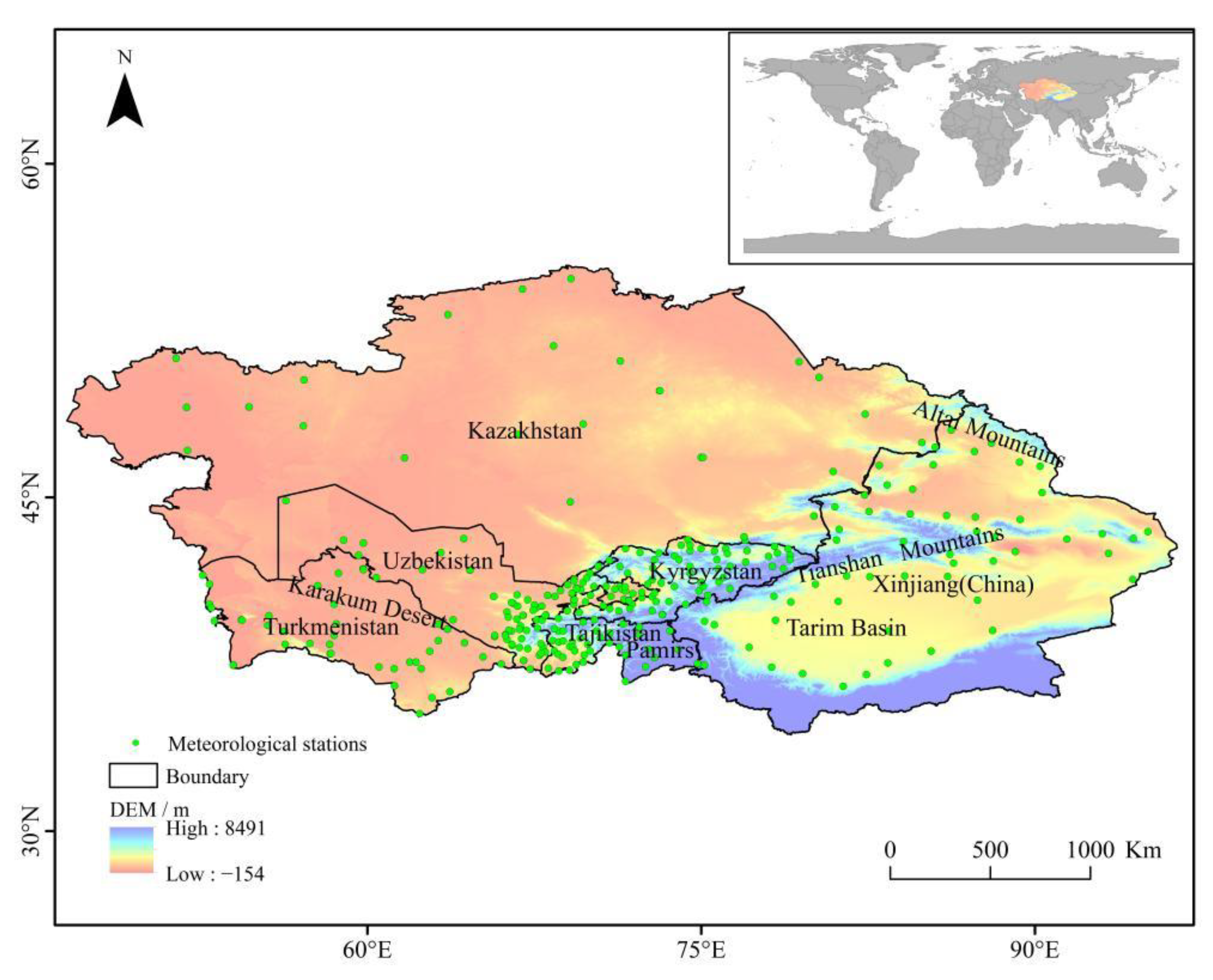
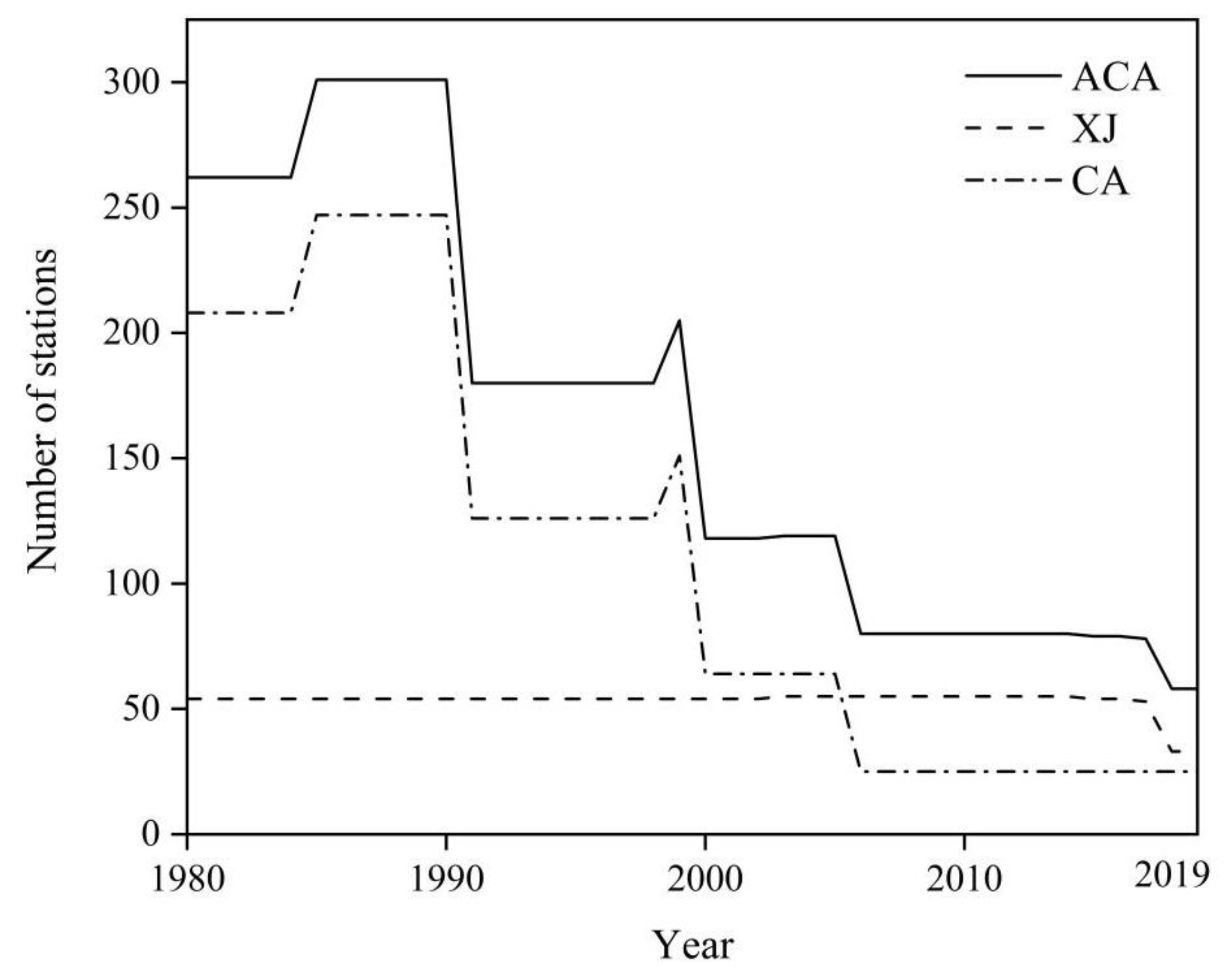
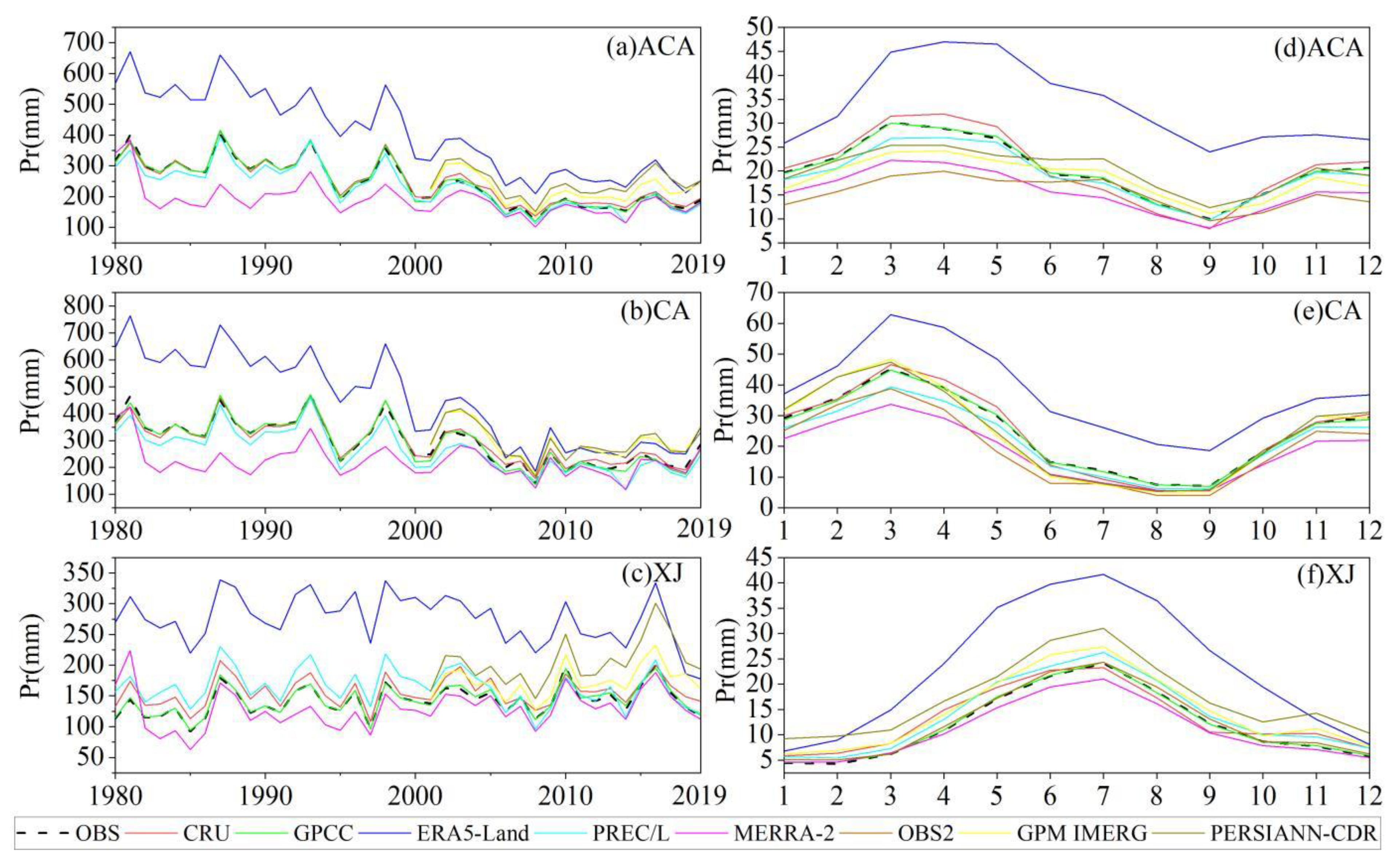
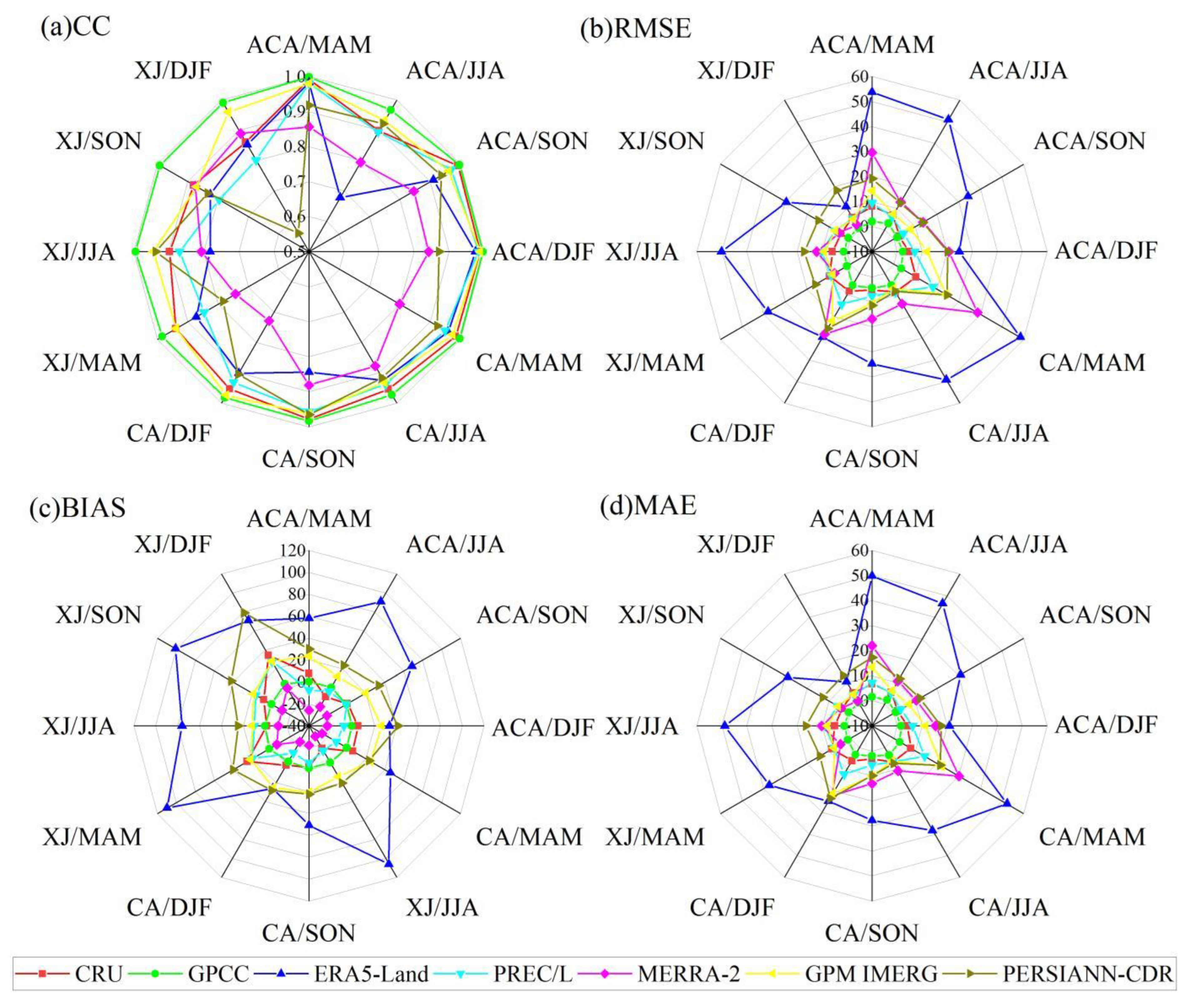
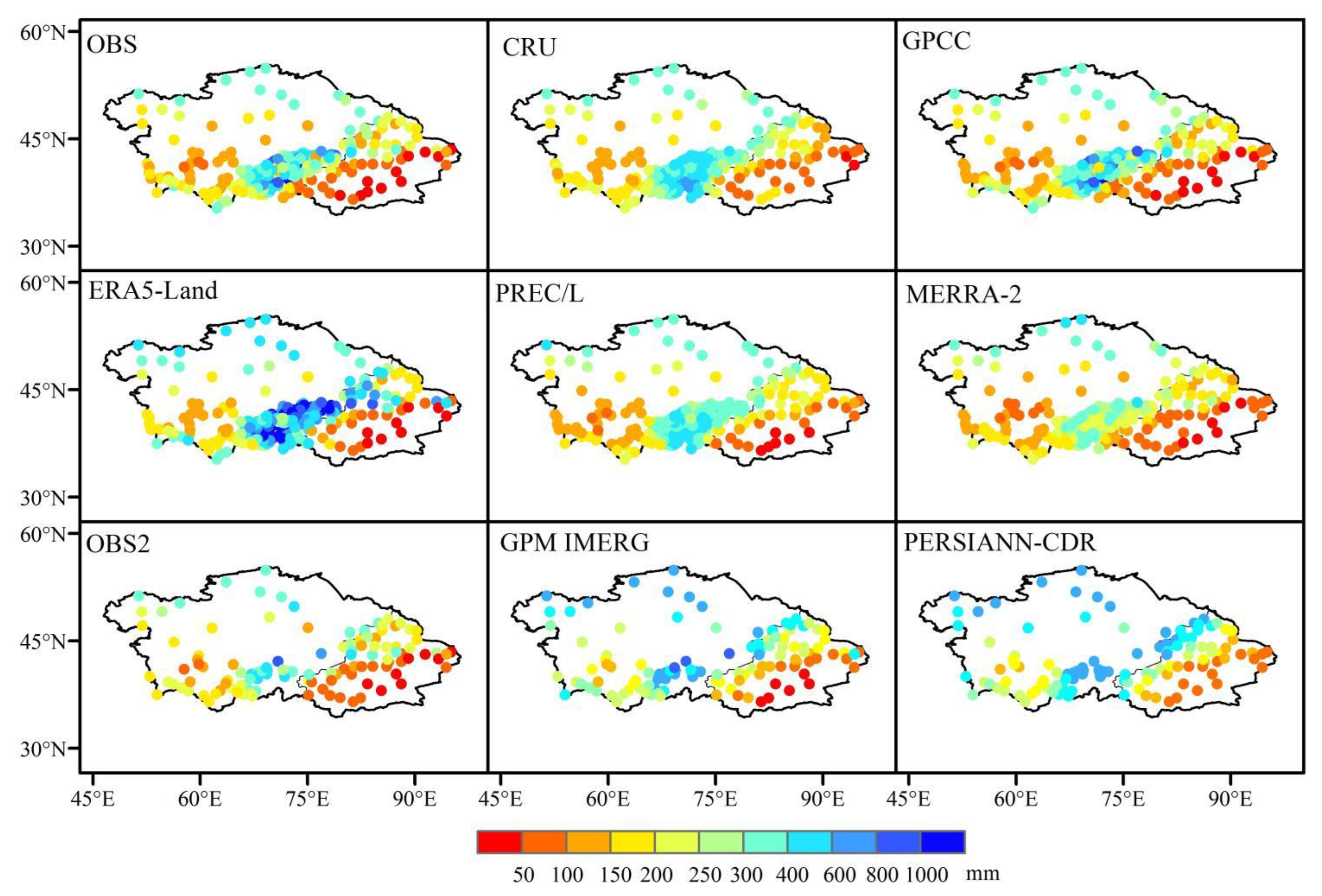
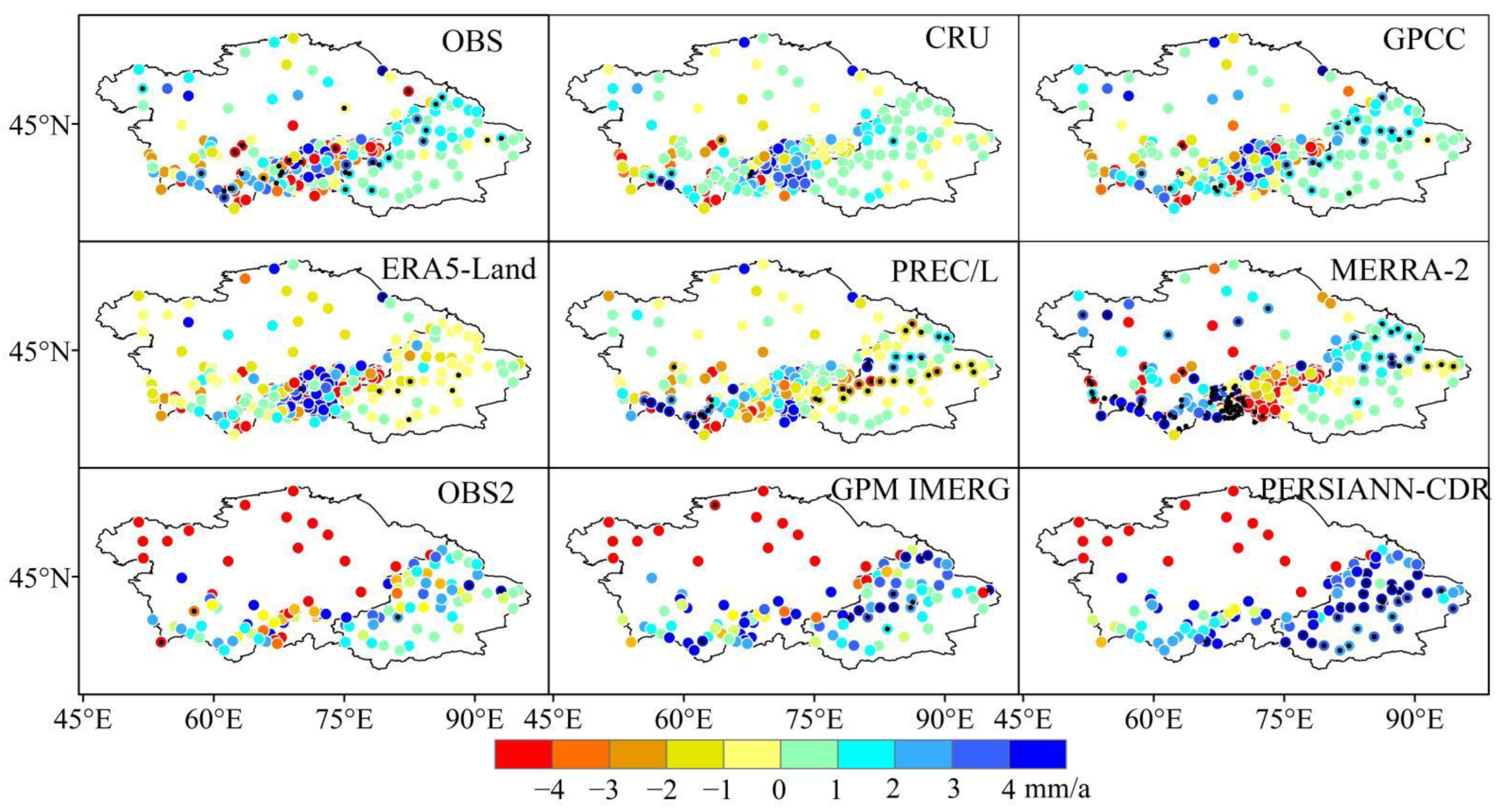
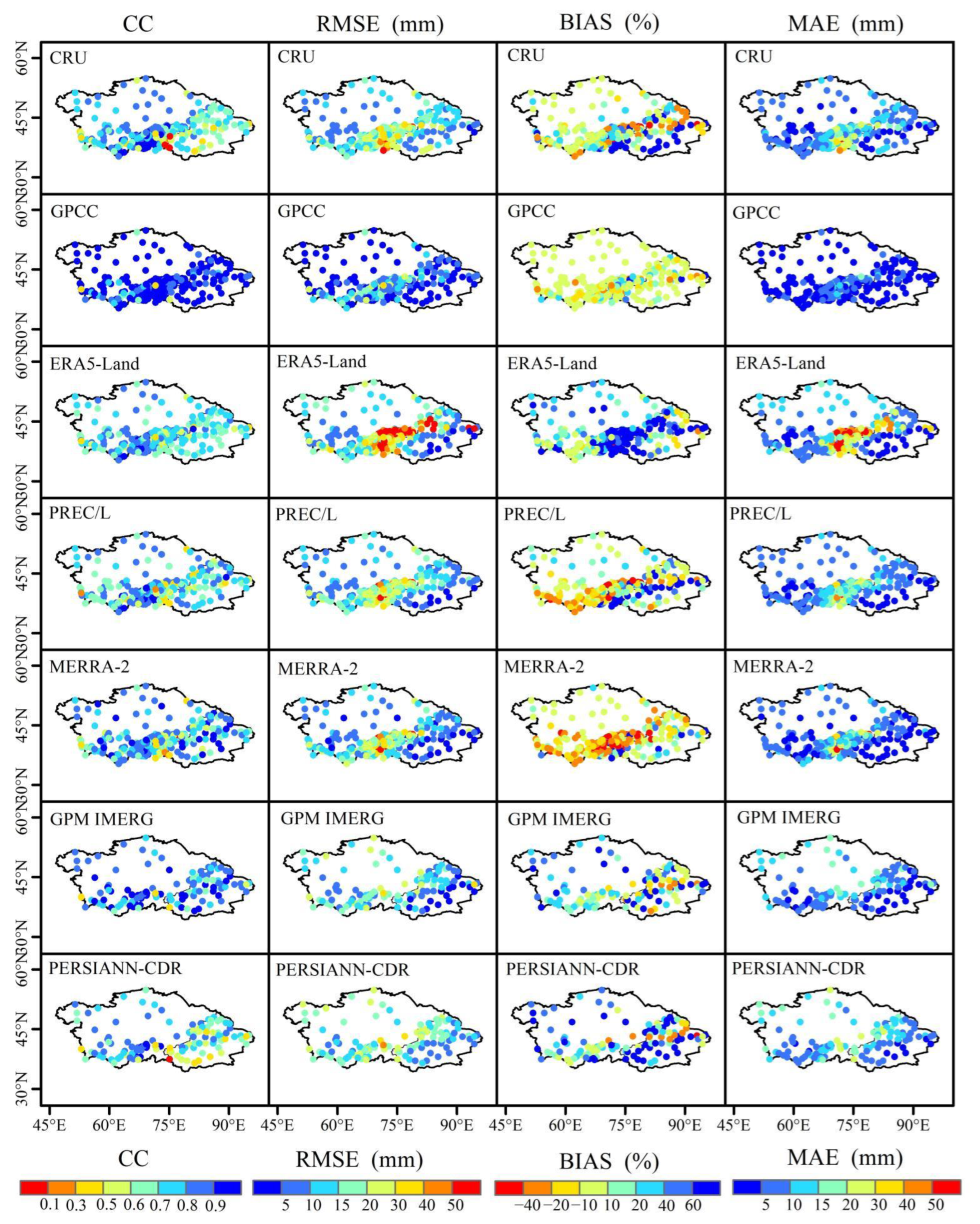
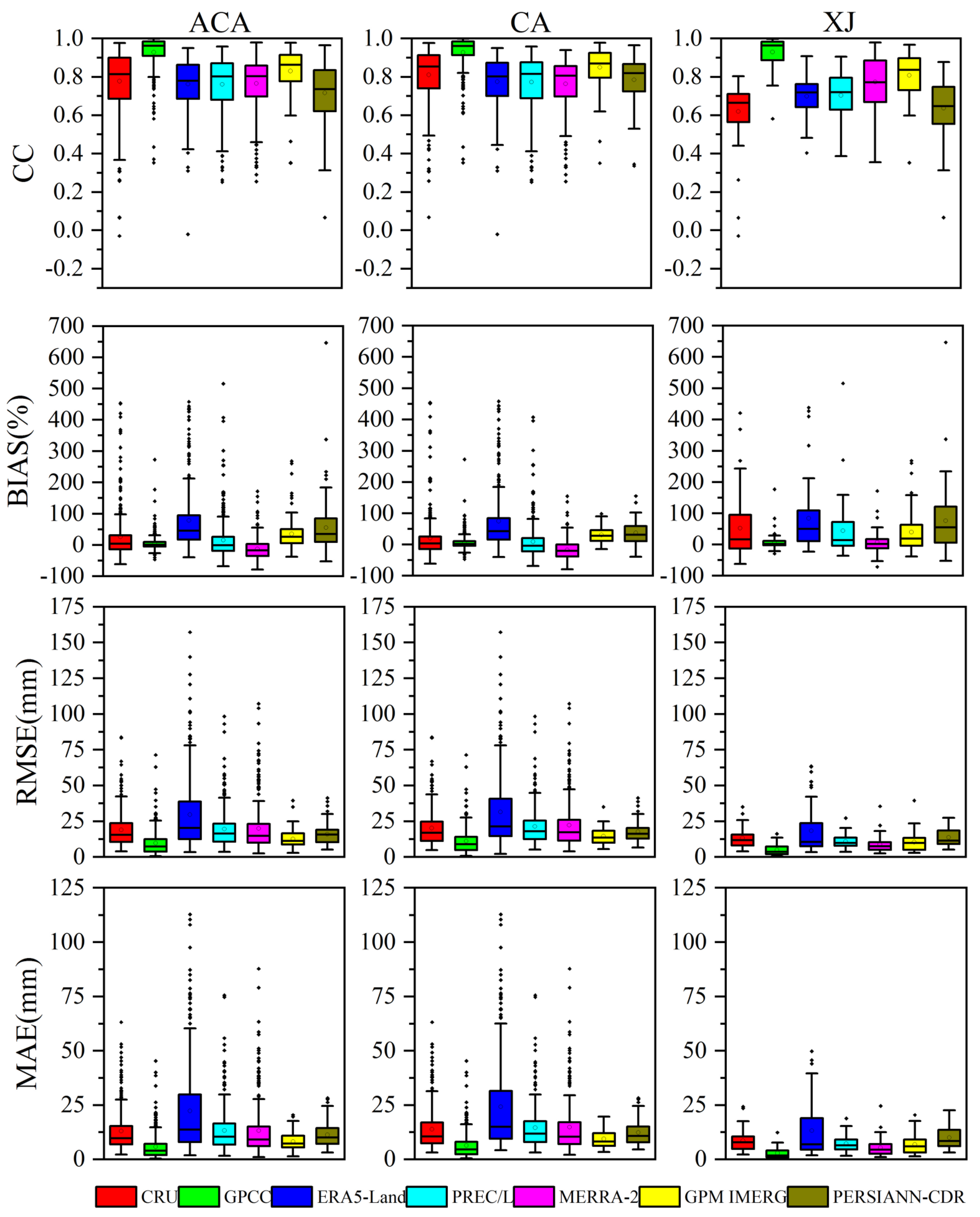

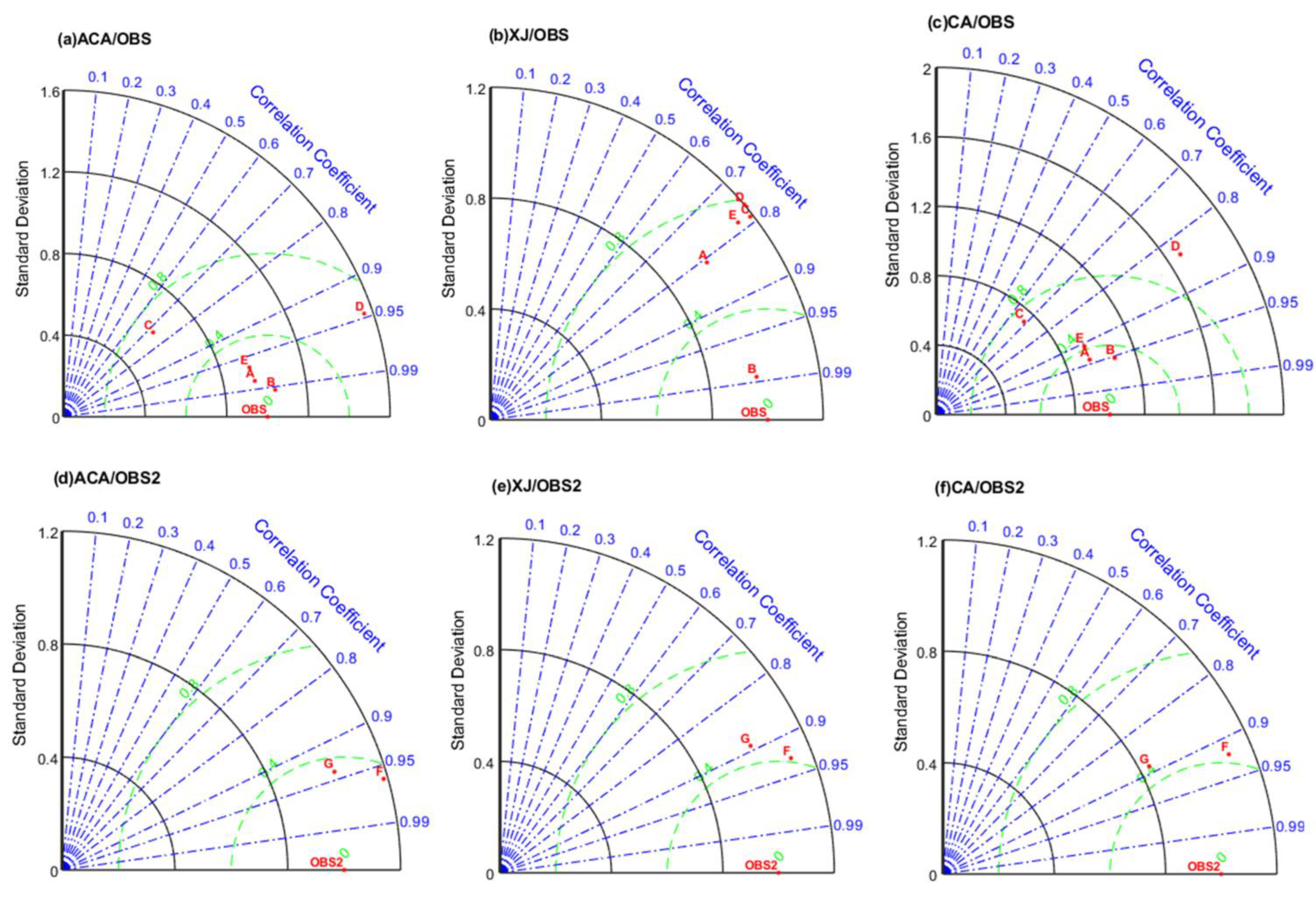
| Name | Time Range | Time Resolution | Spatial Resolution | Data Sources | |
|---|---|---|---|---|---|
| Gauge-based products | CRU | 1901–2020 | Monthly | 0.5° × 0.5° | https://crudata.uea.ac.uk/cru/data/hrg/ (accessed on 6 November 2021) |
| GPCC | 1891–2019 | Monthly | 0.25° × 0.25° | https://www.dwd.de/EN/ourservices/gpcc/gpcc.html (accessed on 6 November 2021) | |
| Reanalysis products | ERA5-Land | 1950–2022 | Monthly | 0.1° × 0.1° | https://cds.climate.copernicus.eu/(accessed on 10 December 2021) |
| PREC/L | 1948–2022 | Monthly | 1° × 1° | https://psl.noaa.gov/data/gridded/data.precl.html (accessed on 6 November 2021) | |
| MERRA-2 | 1980–2022 | Monthly | 0.5° × 0.625° | https://gmao.gsfc.nasa.gov/reanalysis/MERRA-2/ (accessed on 10 December 2021) | |
| Satellite- based Products | GPM IMERG | 2001–2021 | Monthly | 0.1° × 0.1° | https://gpm.nasa.gov/data/directory (accessed on 5 December 2021) |
| PERSIA NN-CDR | 1983–2022 | Daily | 0.25° × 0.25° | http://chrsdata.eng.uci.edu/ (accessed on 21 November 2021) |
| Products | CRU | GPCC | ERA5 -Land | PREC/L | MERRA-2 | GPM IMERG | PERSI ANN-CDR | |
|---|---|---|---|---|---|---|---|---|
| Indices | Region | |||||||
| CC | ACA | 0.993 | 0.997 | 0.968 | 0.986 | 0.770 | 0.971 | 0.919 |
| CA | 0.987 | 0.992 | 0.938 | 0.969 | 0.734 | 0.965 | 0.938 | |
| XJ | 0.924 | 0.994 | 0.737 | 0.767 | 0.744 | 0.905 | 0.833 | |
| RMSE (mm) | ACA | 10.462 | 6.420 | 161.581 | 18.367 | 73.068 | 39.892 | 60.998 |
| CA | 13.548 | 12.379 | 167.179 | 38.090 | 91.889 | 57.986 | 61.869 | |
| XJ | 17.601 | 3.019 | 127.604 | 29.111 | 24.697 | 27.786 | 60.105 | |
| BIAS (%) | ACA | 1.985 | −0.275 | 60.138 | −5.593 | −22.876 | 20.358 | 31.457 |
| CA | 0.404 | −1.322 | 47.051 | −10.898 | −24.769 | 23.238 | 24.484 | |
| XJ | 10.553 | 0.945 | 88.715 | 15.356 | −8.994 | 17.275 | 37.971 | |
| MAE (mm) | ACA | 7.924 | 4.585 | 147.527 | 14.856 | 57.413 | 37.642 | 58.163 |
| CA | 10.443 | 8.662 | 139.503 | 32.783 | 74.520 | 54.628 | 57.557 | |
| XJ | 15.536 | 2.244 | 125.499 | 24.681 | 19.448 | 25.560 | 56.184 | |
Publisher’s Note: MDPI stays neutral with regard to jurisdictional claims in published maps and institutional affiliations. |
© 2022 by the authors. Licensee MDPI, Basel, Switzerland. This article is an open access article distributed under the terms and conditions of the Creative Commons Attribution (CC BY) license (https://creativecommons.org/licenses/by/4.0/).
Share and Cite
Song, L.; Xu, C.; Long, Y.; Lei, X.; Suo, N.; Cao, L. Performance of Seven Gridded Precipitation Products over Arid Central Asia and Subregions. Remote Sens. 2022, 14, 6039. https://doi.org/10.3390/rs14236039
Song L, Xu C, Long Y, Lei X, Suo N, Cao L. Performance of Seven Gridded Precipitation Products over Arid Central Asia and Subregions. Remote Sensing. 2022; 14(23):6039. https://doi.org/10.3390/rs14236039
Chicago/Turabian StyleSong, Lingling, Changchun Xu, Yunxia Long, Xiaoni Lei, Nanji Suo, and Linlin Cao. 2022. "Performance of Seven Gridded Precipitation Products over Arid Central Asia and Subregions" Remote Sensing 14, no. 23: 6039. https://doi.org/10.3390/rs14236039
APA StyleSong, L., Xu, C., Long, Y., Lei, X., Suo, N., & Cao, L. (2022). Performance of Seven Gridded Precipitation Products over Arid Central Asia and Subregions. Remote Sensing, 14(23), 6039. https://doi.org/10.3390/rs14236039



